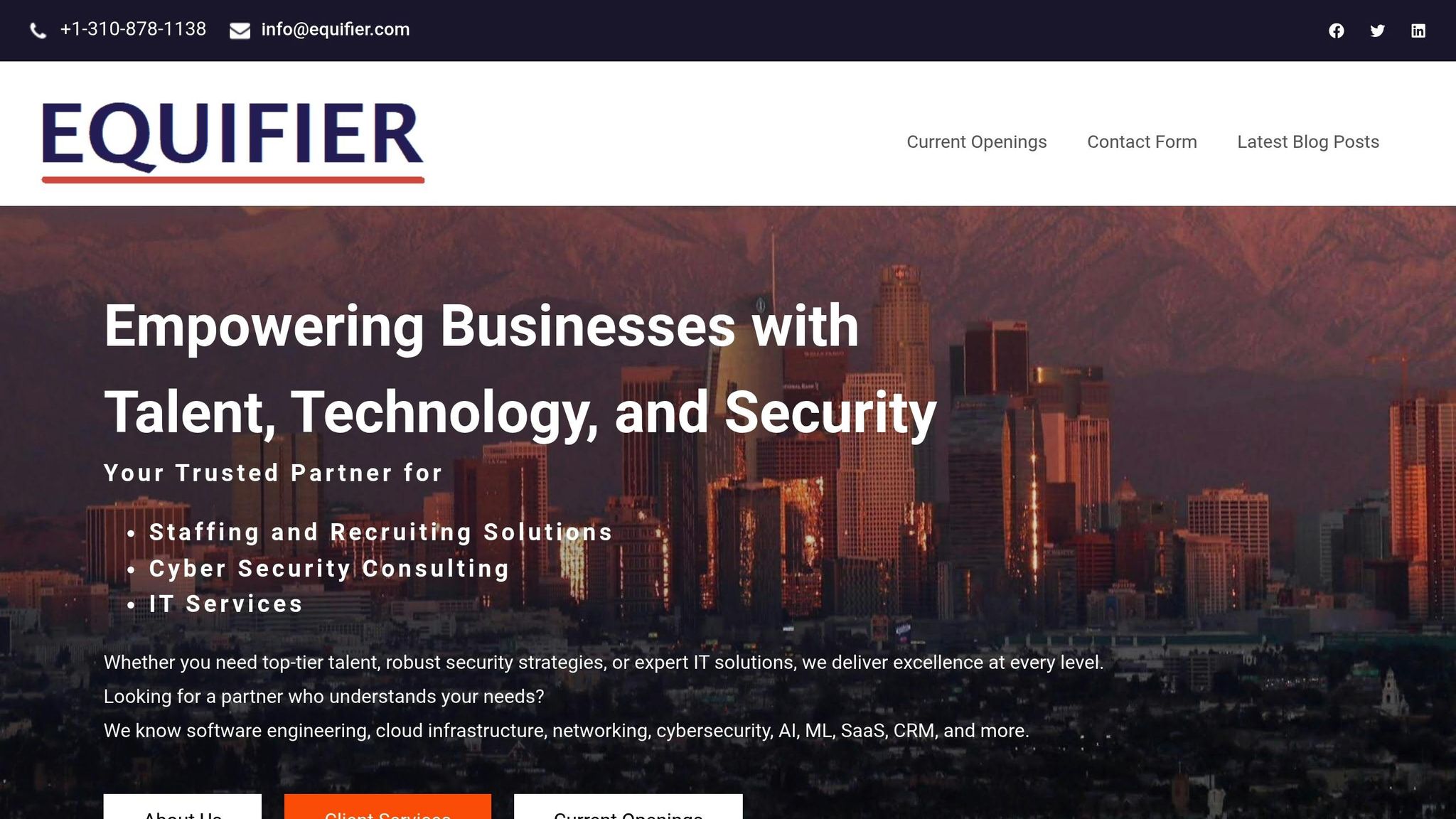Your IT team is the backbone of your business, but sometimes, they need extra support to keep everything running smoothly. Here are 7 signs that your organization might need IT staffing help:
- Missing Skills: Projects slow down because your team lacks the technical expertise needed.
- Delayed Projects: Deadlines are consistently missed due to insufficient capacity or resources.
- Overworked Teams: Employees are stretched too thin, leading to burnout and declining productivity.
- Hiring Challenges: Finding qualified IT professionals feels impossible, and recruitment takes too long.
- Increasing Security Risks: Cybersecurity threats are growing, but your team can’t keep up.
- High Turnover: Burnout and stress cause valuable employees to leave.
- Scaling Issues: Your team can’t grow fast enough to meet business demands.
Key Takeaway: If any of these sound familiar, it’s time to consider external IT staffing. Bringing in skilled professionals – whether for short-term projects or long-term gaps – can help you stay on track, reduce stress for your team, and protect your business from falling behind.
Keep reading to learn how to identify these issues early and take action before they hurt your business.
IT Staffing Solutions
1. Missing Skills Are Slowing Down Projects
When your team doesn’t have the technical know-how to meet project demands, progress can grind to a halt. A skills gap is the difference between the abilities your team currently has and what’s needed to succeed. This gap can derail project timelines and blow budgets across your organization.
Here’s a startling fact: only 30% of IT projects are completed on time, within budget, and with all required features. On average, large IT projects go 45% over budget and 7% over schedule. While many factors contribute to these setbacks, the absence of critical skills is often a major culprit.
Take Target’s 2013 expansion into Canada as an example. The company’s inability to manage the complexities of the project led to a $2 billion loss and 17,600 job cuts. Similarly, TSB Bank’s 2018 platform migration left 1.9 million customers locked out of their accounts and cost the bank £330 million.
But the fallout isn’t limited to individual project failures. IT executives report that talent shortages are the biggest obstacle to adopting 64% of emerging technologies. Without the right skills, your organization risks falling behind competitors who can implement new tools and processes more swiftly. The next step? Identifying which skills are missing so you can address the problem head-on.
Finding Out Which Skills You’re Missing
To tackle delays caused by skills gaps, you need a clear and systematic approach. Common gaps include expertise in programming languages, software development methodologies, database management, cybersecurity, cloud computing, and data analysis. However, the specific gaps in your organization will depend on your current projects, goals, and team strengths.
Start by creating a detailed skills inventory. Outline the technical and soft skills required for every role in your organization. Then, align these with your short-term and long-term business objectives to anticipate future needs.
Use a combination of methods to get a full picture: surveys, interviews, performance evaluations, and project outcomes can all help pinpoint where your team is falling short. While self-assessments encourage team members to reflect on their abilities, objective tools like code reviews, peer feedback, and client insights provide a more accurate assessment.
Don’t stop there. Benchmark your findings against industry standards. Review reports and participate in professional forums to see what skills similar companies are prioritizing. Are there emerging technologies or trends that your team needs to prepare for? Staying informed helps you understand where you stand – and where you need to go.
Finally, connect your findings to performance metrics. How are current skills impacting project outcomes? External feedback from clients and partners can also reveal blind spots that internal evaluations might miss.
Getting External Expertise
Once you’ve identified the gaps, bringing in external expertise can provide a quick fix. According to recent data, 87% of businesses acknowledge they’re facing – or will soon face – skill shortages. Yet, only 40% of employees feel their workplace offers sufficient opportunities for upskilling. Even when training is available, developing true expertise takes time. A developer, for instance, might need months to master a new programming language or cloud platform.
Traditional hiring isn’t always a practical solution. Recruitment can take months – time that stalled projects simply don’t have. External staffing, on the other hand, allows you to tap into professionals with the exact skills you need, immediately. For example, instead of spending months training someone on AWS architecture, you can bring in a cloud specialist who’s ready to contribute from day one.
For skills that aren’t needed full-time, contracting experts on a project basis often makes more sense financially. Why hire a full-time employee for a niche skill set that’s only occasionally required? A flexible approach, blending full-time staff with specialized contractors, offers the best of both worlds. Your core team handles day-to-day operations while external professionals address specific gaps or short-term needs. This strategy allows you to scale up or down based on your current demands without the long-term commitment of permanent hires.
Companies like Equifier specialize in connecting organizations with IT professionals who can fill these gaps. Whether you need a cybersecurity expert to shore up defenses, a data scientist to uncover insights, or a DevOps engineer to optimize deployments, the right talent is out there.
But speed is key. Employers estimate that 44% of workers’ skills will be disrupted in the next five years. With the landscape shifting so rapidly, addressing skill shortages promptly is essential to keeping your projects on track.
2. Projects Keep Getting Delayed
When IT projects consistently miss their deadlines, it’s not just an issue of poor scheduling – it’s a red flag that your organization might need extra staffing support. Statistics show that 43% of completed projects exceed their budgets, and 48% miss their deadlines. Even more concerning, 70% of software projects face major delays.
These delays don’t just push back launch dates – they can damage your reputation, lead to costly rework, and throw off subsequent projects. On top of that, communication breakdowns alone cost businesses a staggering $62.4 million annually.
A lack of workforce capacity or the necessary skills is often the root cause of these delays. Even when projects are carefully planned, the absence of the right people in the right roles can derail timelines. Pinpointing these issues is the first step toward finding effective staffing solutions.
Finding Out Why Projects Are Late
Project delays rarely boil down to just one issue. Common causes include poor communication, flawed planning, inaccurate timelines, competing priorities, scope creep, and incomplete or underqualified teams. To tackle delays effectively, start by analyzing where things are going wrong.
Look closely at communication processes. Are messages getting lost? Are priorities clashing? Next, assess your team’s workload and skill sets. If the same employees are juggling multiple projects, delays are almost inevitable. For example, your developers might be highly skilled but overwhelmed by competing deadlines – or you might lack critical expertise in areas like cybersecurity.
Another common culprit is scope creep – when project requirements expand beyond the original plan without adjusting timelines or resources. Imagine a team working on a CRM system suddenly being asked to add advanced reporting, integrate external systems, and build custom interfaces. Each of these changes requires additional time, resources, and testing, which can inflate costs and extend deadlines significantly.
Tools like time trackers can help you compare actual task durations with your initial estimates, revealing patterns that contribute to delays. Post-project reviews are equally valuable. Document what went wrong, what went well, and what could be improved. These insights often highlight whether internal capacity issues could be addressed by bringing in external support.
Using Contract Staff to Meet Deadlines
If workforce limitations are the root of your delays, contract staffing offers an immediate solution. Contractors bring specialized skills to the table without the need for lengthy onboarding or training, saving precious time and helping projects stay on track.
By 2030, the global workforce may face a shortage of 85 million jobs, with a significant gap in tech talent. Instead of waiting months to hire permanent employees, contract professionals can step in right away to fill skill gaps and handle capacity issues. These experts are particularly effective at addressing the specific problems causing delays. Whether it’s solving technical challenges, speeding up feature development, or ensuring code quality, contractors can keep the momentum going.
One of the biggest advantages of contract staffing is flexibility. Contractors can quickly adapt to shifting project requirements and tight deadlines. Whether you need expertise in DevOps, cybersecurity, or another specialized area, contract professionals can step in and ensure your project stays on schedule.
This approach is becoming increasingly popular. In fact, the World Economic Forum predicts that 41% of organizations plan to expand their use of contractors by 2025. This reflects the growing need for specialized skills on a short-term basis – exactly the kind of support contract staffing provides.
To make the most of contract staff, it’s essential to define the project scope and required skills clearly from the outset. Establish clear reporting structures and communication channels to ensure smooth integration with your team.
If you’re looking for experienced IT professionals to help meet critical deadlines, Equifier can connect you with the right talent. Whether you need someone for a few weeks to resolve a specific issue or several months to complete a major project phase, expert help is just a call away.
3. Your Internal Teams Are Overworked
When IT teams are stretched too thin, the impact is hard to ignore. A staggering 53% of IT professionals regularly feel overwhelmed, leading to stress that can hurt both productivity and the company’s bottom line. Work-related stress contributes to an extra $190 billion in annual healthcare costs, and replacing burned-out employees can cost six to nine months of their average salary. Recent statistics paint a troubling picture: 60.2% of workers report experiencing burnout, and 78.7% of professionals struggle with unmanageable workloads.
Just like skill shortages and delayed projects, overworked teams can derail operational success. This highlights the importance of strategic IT staffing to keep projects moving forward.
"It’s also our collective delusion that overwork and burnout are the price we must pay in order to succeed." – Arianna Huffington
Signs Your Teams Have Too Much Work
Overworked teams often show signs that can easily go unnoticed until productivity takes a nosedive. For example:
- Declining work quality: Developers logging 12–16 hour days may miss critical bugs due to mental fatigue. Persistent errors can signal that even the most reliable team members are stretched beyond their limits.
- Productivity paradox: While longer hours might seem like a solution, productivity actually drops after 50 hours per week and plummets further after 60 hours. Disengaged employees, often a result of overwork, make 60% more errors .
- Health and safety risks: Excessive overtime isn’t just bad for output – it increases workplace injury rates by 61% and raises the likelihood of depression and other mental health challenges.
- Team dynamics suffer: Overwork erodes communication, stifles collaboration, and slows innovation. This can lead to a direct hit on customer satisfaction, with 33% of companies risking client loss due to overburdened teams.
These warning signs don’t just affect team performance – they underscore the urgent need for solutions that restore balance.
Reducing Workloads with External Staffing
External staffing offers a practical way to manage workloads and prevent burnout, addressing a global issue where 80% of knowledge workers feel overworked and on the brink of burnout.
- Strategic resource allocation: By assigning high-priority tasks to your core team and outsourcing overflow or specialized work, you can ensure your top talent isn’t spread too thin. Contractors can step in to handle specific projects, allowing your team to focus on what matters most.
- Immediate expertise without long-term commitments: External professionals can tackle complex tasks like cybersecurity compliance or cloud migrations without adding permanent headcount. This keeps your team focused on daily operations while still moving major projects forward.
- Flexible scaling: Workload fluctuations are inevitable, but external staffing helps you adapt quickly. This flexibility is crucial, especially when 78% of organizations abandon projects midway due to skill gaps and overwork. Regular check-ins with your teams can also catch unmanageable workloads early, avoiding burnout and disengagement – issues that 82% of employees cite as reasons for feeling less engaged.
"If you overwork your high performers, you will lose them because they start to resent the fact that they’re doing more." – Julie Morgenstern, Organizing and productivity expert
When overwork becomes a problem, Equifier can connect you with the right external talent to ease the load. Whether you need temporary project support or specialized expertise, the right staffing solutions can help your team regain focus, boost productivity, and maintain job satisfaction – all while keeping your projects on track.
4. You Can’t Find Good IT Candidates
Finding qualified IT professionals is becoming more challenging than ever. A staggering 69% of recruiters and employers report difficulties in locating skilled IT candidates. The situation is even more pronounced in specialized fields: over 21% of IT recruiters worldwide anticipate struggles in hiring AI and machine learning experts by 2025. If your internal recruiting efforts are consistently coming up short, it might be time to consider specialized staffing solutions to access the talent you need.
The statistics reveal just how inefficient traditional recruitment can be. For example, three out of four recruiters have noticed a sharp rise in applications per open position. A typical job posting might attract around 250 applications, yet only four or five candidates are qualified enough to move forward to the interview stage. This leaves HR teams spending countless hours sorting through unqualified applicants instead of focusing on higher-value tasks. Much of this inefficiency comes from outdated recruitment strategies and an overdependence on generic job platforms.
Why Your Hiring Efforts Aren’t Working
Traditional hiring methods simply don’t cut it in today’s highly specialized IT field. In 2023, 63% of all applications went through job boards, reflecting a heavy reliance on platforms that cater to general audiences and often fail to attract niche talent. These methods also tend to overlook passive candidates, who make up more than 70% of the potential talent pool, while only 15% of developers are actively seeking new roles. Adding to the challenge, 65% of companies admit they struggle with effectively using technology and analytics in recruitment. Geographic constraints further complicate matters, with 75% of global organizations reporting difficulties in finding top-tier candidates.
Finding More Candidates Through Equifier

Equifier offers a tailored solution to these recruitment challenges, addressing the root causes head-on. Nearly 90% of companies now turn to staffing agencies, which can help save an average of 25% on hiring costs. Equifier taps into a curated pool of pre-screened, industry-specific talent – including passive candidates – to simplify the hiring process and cut expenses. This is especially important given that 72% of candidates say the ease of the interview process influences their decision to accept a job.
Equifier’s extensive national network eliminates geographic barriers, helping overcome local talent shortages. Their efficient screening process means your HR team can spend less time reviewing resumes and more time driving strategic growth – a crucial advantage when turnover costs can range from 90% to 200% of an employee’s annual salary. With Equifier, you’ll find candidates who not only meet technical requirements but also align with your company’s culture, enabling you to build and scale your team with confidence and efficiency.
sbb-itb-05efa2a
5. Security Threats Are Increasing
Cybersecurity threats are evolving at an alarming rate. A staggering 75% of professionals report growing challenges, while 70% of organizations are grappling with heightened risks due to talent shortages. The numbers don’t lie – the cybersecurity workforce is in crisis. According to the 2021 (ISC)² Cybersecurity Workforce Study, the U.S. alone needs 377,000 workers to fill open cybersecurity roles. Globally, that gap widens to over 2.7 million professionals. Recent data from CyberSeek paints an even grimmer picture, revealing more than 457,000 unfilled cybersecurity positions in the U.S. today.
The impact of this shortage is clear: nearly 70% of security leaders admit their organizations face increased risks due to a lack of skilled personnel. Even more concerning, fewer than 15% of organizations feel confident they have the right people and expertise to meet their cybersecurity goals. When teams are understaffed, critical tasks like monitoring for threats or patching vulnerabilities may be delayed – or skipped entirely – leaving organizations wide open to attacks. These escalating threats highlight the urgent need to identify and address security weaknesses before they’re exploited.
Finding Security Weaknesses
The first step in defending against cyber threats is understanding where your vulnerabilities lie. Conducting a thorough assessment of your cybersecurity posture can reveal issues such as outdated systems, insufficient data backups, insecure use of personal devices, or even the absence of a comprehensive cybersecurity strategy. Organizations that wait for a breach to occur before taking action – rather than proactively preventing incidents – are putting themselves at greater risk. A lack of visibility into user activity can also allow potential compromises to go unnoticed, creating further exposure.
Leadership plays a critical role here, but many cybersecurity executives are under immense pressure to maintain security with limited resources. To effectively assess and strengthen your defenses, your team needs expertise in areas like cloud security, artificial intelligence (AI) and machine learning security, zero trust architecture, and penetration testing. Without these specialized skills, major vulnerabilities could remain hidden, leaving your organization exposed.
Mitigating Risks with Expert Staff
Once you’ve identified the gaps in your defenses, the next step is to address them with the right expertise. External cybersecurity specialists can be invaluable in this process, helping your organization shift from a reactive approach to a proactive one. These experts bring fresh perspectives, often spotting vulnerabilities that internal teams might overlook. They can also establish strong security policies and frameworks that align with industry best practices.
Compliance is another critical element of cybersecurity. Adhering to regulations like GDPR, HIPAA, and PCI-DSS isn’t just about avoiding fines – it’s about protecting your organization’s reputation and customer trust. For example, violations of GDPR can result in penalties of up to €20 million or 4% of annual global revenue, whichever is higher. External specialists can ensure your compliance by conducting gap analyses, implementing robust controls, and developing effective incident response plans.
Partnering with a firm like Equifier for cybersecurity staffing can make a significant difference. Their specialists work alongside your in-house IT team, staying on top of industry trends, recommending updates to your security programs, and continuously monitoring for vulnerabilities. This approach is especially crucial given that more than 65% of organizations report a moderate to critical skills gap in cybersecurity. By leveraging external expertise, your organization will be better equipped to navigate today’s increasingly dangerous threat landscape.
6. Employees Keep Quitting or Burning Out
The challenges of overwork often lead to two critical issues for IT operations: burnout and high turnover. These problems have reached alarming levels in the industry. When employees frequently quit or show signs of exhaustion, it’s a clear signal that your team needs extra support. With 76% of employees experiencing burnout and 44% of U.S. workers reporting feeling burned out, the strain on organizations is undeniable . Burned-out employees are nearly three times more likely to look for a new job.
The financial toll is enormous. Severely burned-out workers are 63% more likely to take sick days, costing the U.S. workforce around $47.6 billion annually in lost productivity. Add in the expenses of recruiting and training new hires, and businesses face losses that could reach $1.8 trillion each year. Addressing burnout isn’t just about supporting employees – it’s also a smart financial move. These numbers reflect the real-world challenges burnout creates for IT teams.
How Burnout Affects Your Team
Burnout doesn’t just impact individuals – it ripples through entire teams. The signs often start small but can grow into significant disruptions. Employees dealing with burnout may feel exhausted, unmotivated, cynical, or irritable. This leads to poor concentration, reduced productivity, and increased absenteeism . In IT, these symptoms can result in missed deadlines, subpar work quality, and an overall slowdown that affects the entire team.
"When workers are suffering from burnout, their productivity drops, and they may become less innovative and more likely to make errors. If this spreads throughout an organization, it can have a serious negative impact on productivity, service quality, and the bottom-line." – Dennis P. Stolle, JD, PhD, APA’s senior director of applied psychology
The effects of burnout are especially harmful in technical roles. It can impair short-term memory, focus, and other vital cognitive functions. For example, developers might struggle with debugging, system administrators could overlook critical updates, and project managers may lose track of deadlines. These are predictable outcomes of chronic stress in the workplace.
Burnout also disrupts team dynamics. Exhausted employees often withdraw from collaboration or avoid team interactions altogether. They may respond defensively to feedback or develop a negative outlook on their work and the organization. This creates a vicious cycle where their teammates must shoulder additional responsibilities, increasing their own risk of burnout.
Gender disparities further complicate the picture. Women report higher burnout rates than men, with 77% saying they’ve considered quitting due to work-related stress, compared to 66% of men. Women are also more likely to leave their jobs because of stress or burnout (39% vs. 25%). For IT departments already working to improve diversity, losing female talent to burnout only amplifies existing challenges. These issues call for immediate action to restore balance and support the workforce.
Using Flexible Staffing to Balance Workloads
The answer isn’t always hiring more full-time employees – it’s about creating flexible staffing strategies that adjust to fluctuating workloads and provide relief to overburdened teams. Flexible staffing allows your core team to focus on essential tasks while specialized contractors handle temporary surges, fill skill gaps, or bring fresh energy to stalled projects. This approach ensures your permanent staff isn’t overwhelmed with every urgent demand.
Modern staffing solutions go beyond simply filling vacancies. Staffing agencies today match candidates not just by technical skills but also by team compatibility, project needs, and company culture. Instead of waiting for employees to burn out and quit, proactive flexible staffing can help prevent these issues. For example, you could bring in contract developers during crunch times, hire temporary system admins for major migrations, or add project managers for complex initiatives. The goal is to maintain manageable workloads for your core team while keeping projects on track.
Equifier specializes in flexible IT staffing solutions designed to ease workloads, reduce stress on internal teams, and improve employee retention. By partnering with Equifier, you can quickly access specialized talent without committing to permanent hires. This flexibility lets you scale your team up during busy periods and down when projects wrap up, keeping staffing levels efficient throughout the year.
Flexible staffing doesn’t just reduce burnout – it also helps retain talent. Employees facing burnout are less engaged, more likely to quit, and up to 2.1 times more likely to look for other jobs. By managing workloads effectively through flexible staffing, you safeguard your investment in your team and create a more sustainable, supportive work environment for everyone.
7. You Can’t Grow Your Team Fast Enough
Expanding your IT team quickly has become a critical factor for staying ahead in today’s competitive landscape. If your organization struggles to scale its technical workforce at the pace your business demands, you’re facing more than just hiring headaches – you’re dealing with a bottleneck that can derail key initiatives and disrupt your overall strategy.
When teams lack the bandwidth to meet project demands, delays pile up, quality suffers, and critical processes like development and QA take a hit. Feature requests get pushed down the priority list, specialized roles become choke points, and there’s little room to explore tools or technologies that could boost efficiency. In short, the inability to grow your team fast enough can hold your entire business back.
Why Rapid Team Expansion Is Crucial
In the fast-moving tech world, the ability to quickly scale your team isn’t just a nice-to-have – it’s a strategic necessity. A slow hiring process can leave you lagging behind competitors who are better equipped to capitalize on market opportunities. Timing is everything, and companies that can assemble the right talent quickly gain a distinct edge.
Consider this: the IT outsourcing market hit $484.86 billion in 2023 and is expected to grow to $812.75 billion by 2029. This surge underscores a global shift – traditional hiring methods just can’t keep up with the speed of modern business. Flexible staffing solutions are becoming the go-to option because they allow companies to respond to market demands without the delays of conventional recruitment.
Quickly scaling IT teams also accelerates project timelines, enabling faster product launches. With access to specialized expertise, your in-house team can focus on high-priority tasks instead of stretching themselves thin with responsibilities outside their core strengths. This targeted approach leads to smoother operations and frees up permanent staff to work on initiatives that directly drive growth.
The financial benefits are hard to ignore. IT staff augmentation can save businesses up to 85% compared to hiring full-time employees for similar roles. And it’s not just about cost savings – 76% of executives outsource IT functions to tap into specialized skills that are difficult to find locally. This makes rapid scaling a strategic move, offering both economic and operational advantages.
How Equifier Simplifies Scaling
Equifier steps in to bridge talent gaps with its IT staff augmentation services, giving businesses instant access to a global pool of skilled professionals. Unlike traditional hiring processes that can drag on for months, Equifier enables you to scale your workforce up or down in a matter of days, all while avoiding the long-term costs and commitments of full-time hires.
The platform excels at providing specialized skills that may be scarce in your local market. Whether you’re looking for cloud architects for a major digital transformation, cybersecurity experts for compliance projects, or full-stack developers to speed up application development, Equifier’s network of pre-vetted professionals is ready to hit the ground running.
But Equifier goes beyond just filling roles. Their model ensures that you maintain control over your projects while benefiting from external expertise. This means you can align the work with your business goals without losing ownership of the process.
The onboarding process is built for speed and efficiency. With clear communication channels, defined expectations, and user-friendly collaboration tools, Equifier ensures that external team members integrate seamlessly with your in-house staff. This setup minimizes the usual adjustment period, allowing new team members to contribute effectively from day one.
Key benefits of Equifier’s approach include:
- Flexible scaling to match project demands
- Cost savings by paying only for the resources you need
- Access to a global pool of specialized talent
- Retention of project control and strategic direction
- Faster time-to-market through rapid team deployment
Conclusion: Working with Equifier for IT Staffing Success
Gaps in skills, delayed projects, overburdened teams, hiring challenges, security risks, and scaling difficulties can significantly disrupt your operations. In fact, these issues can cost your organization up to 30% of a new hire’s first-year earnings. Often, poor hiring metrics make these problems worse. However, early IT staffing support can help you avoid delays, reduce burnout, address security risks, and maintain business continuity.
These high stakes highlight the importance of expert IT staffing solutions. Equifier’s focused approach tackles these issues head-on. Whether it’s bridging skill gaps, meeting tight deadlines, or preventing burnout, Equifier connects you with a network of pre-vetted professionals who integrate quickly and adapt to your project needs. From cybersecurity specialists addressing vulnerabilities to contract developers meeting critical deadlines or seasoned project managers leading complex initiatives, Equifier provides the flexibility to scale resources as needed.
Partnering early with specialized staffing providers like Equifier offers clear advantages. It not only speeds up the hiring process but also improves long-term workforce planning. This proactive approach ensures better alignment of skills, reduces hiring time, and gives your organization the scalability to adapt to market changes.
By monitoring key metrics such as project completion rates and time-to-fill positions, you can stay ahead of potential issues. When these indicators point to trouble, having an established relationship with Equifier allows you to act quickly – avoiding the chaos of last-minute staffing decisions.
Take a close look at your IT capacity and how it aligns with your business goals. Partnering with Equifier ensures you’re equipped with proactive IT staffing solutions that address immediate needs while supporting strategic workforce planning for the future. The most successful organizations identify staffing challenges early and work with experts to achieve both short-term success and long-term growth.
FAQs
How can I identify skill gaps in my IT team to keep projects on track?
To pinpoint skill gaps within your IT team, begin by comparing your team’s current abilities to the specific skills required for upcoming projects. Tools like skills assessments, performance reviews, and manager feedback can provide valuable insights. Additionally, patterns such as missed deadlines, recurring technical issues, or unresolved support tickets can reveal areas where expertise may be insufficient.
After identifying these gaps, explore options like tailored training programs or hiring specialized IT professionals on a flexible basis. Continuously reviewing team performance and project results helps you anticipate future needs and keep operations running smoothly.
What are the advantages of hiring contract IT staff instead of full-time employees to address project delays and skill gaps?
When project delays or skill shortages arise, hiring contract IT staff can be a smart move for businesses. These professionals can be brought on board quickly, offering immediate support to keep projects moving forward without the lengthy timelines involved in hiring full-time employees. Plus, they often come with specialized skills tailored to the unique needs of a project, helping to bridge gaps and ensure tasks are completed more efficiently.
Another big advantage? Contract staffing can be a cost-efficient option. By avoiding expenses like benefits, long-term salaries, and other overhead costs tied to permanent employees, companies can better manage their budgets. This flexibility is especially valuable for businesses dealing with fluctuating workloads or temporary surges in demand.
How can Equifier help improve my organization’s cybersecurity strategy?
Partnering with Equifier gives your organization access to skilled cybersecurity professionals who can help fortify your defenses against ever-changing threats. These specialists focus on implementing forward-thinking security strategies, keeping an eye out for potential vulnerabilities, and ensuring your organization stays aligned with industry regulations. The result? A reduced risk of breaches and operational disruptions.
On top of that, Equifier simplifies the hiring process, saving you from challenges like skill mismatches or recruitment delays. This means you’ll have the right experts in place to safeguard your sensitive data and maintain a secure, smooth-running operation.









